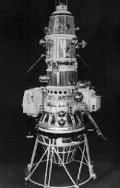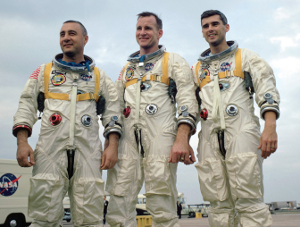The Race to the Moon
The American space program expanded the size of its capsules with Project Gemini, a series of two-person craft that totaled 12 missions in all, featuring some of the men who would go on to walk on the Moon. Filling the roster for Project Gemini were members of Astronaut Group 2 and Astronaut Group 3. 
In 1966, the Soviet Union's Luna 9 made a soft landing on the Moon and transmitted the first images from the lunar surface; later that year, Luna 10 became the first probe to establish lunar orbit. Even though the Soviet cosmonauts had already done such things, American astronauts conducted docking maneuvers and spacewalks. Ed White conducted America's first spacewalk, on June 3, 1965, three months after Alexei Leonov of the Soviet Union had performed the first-ever spacewalk, a 12-minute departure from Voskhov 2. The Gemini astronauts also practiced routine things, like eating in space and sleeping in space and getting along with each other in cramped quarters. In the end, the astronauts and NASA officials declared Project Gemini a success. The next step was the Apollo program, with the destination a manned mission to land on the Moon. Apollo 1Apollo 1, the first to reach the testing stage after the successes of Project Mercury and Project Gemini was originally called Apollo-Saturn 204, or AS-204 or Apollo 204. It was only after the launch pad incident that the mission was termed Apollo 1. 
The original crew of Apollo 1, as assigned by Director of Flight Crew Operations Deke Slayton, was Mercury and Gemini veteran Gus Grissom (left, left) as Command Pilot, Gemini veteran Ed White (left, center) as Senior Pilot, and rookie Donn Eisele as Pilot. Gemini communications veteran Roger Chaffee (left, right) replaced Eisele when the latter dislocated his shoulder during weightlessness training. The launch date was Feb. 21, 1967. On January 27, a little more than three weeks before launch, the crew conducted a "plugs-out" test, a run-through for the spacecraft with all of the cables and umbilicals removed. The test was not a new thing: Scientists had performed numerous such tests for both Mercury and Gemini. The "plugs-out" test was classified as nonhazardous the spacecraft had no fuel or cryogenics in it. Further, any explosive bolts had been removed. Inside the command module, the atmosphere was 100 percent oxygen. Some scientists had suggested that the atmosphere be a mix of nitrogen and oxygen, much as the air that people breathe every day. However, fresh in the minds of organizers was the experience of test pilot G.B. North, who, while testing a Mercury atmosphere system, had gone unconscious and seriously hurt himself because the atmosphere was too high in nitrogen. As well, thinking ahead to the Moon, NASA wanted to streamline the breathing protocol of the astronauts with regard to their spacesuits, and a pure oxygen atmosphere made this process faster than did a nitrogen-oxygen mix. And yet, a fire broke out inside the capsule and, fueled by the oxygen-rich atmosphere, severely damaged the capsule and, more tragically important, killed the crew. Chafee, Grissom, and White were mourned nationwide. Condolences came in from around the world. Many questioned the wisdom of continuing the space program. NASA Administrator James Webb instituted a review, and an extremely thorough investigation followed. Through intensive testing and reconstruction of the events that led to the fire, scientists discovered that a spark in a wire bundle had started the fire and that the fire had fed hungrily on the oxygen-rich atmosphere inside the spacecraft. The investigation also discovered that inside the spacecraft were large amounts of Velcro, which the astronauts had asked to be removed because they considered it to be too much of a fire risk and had indeed been removed but had put back in at a later date. Next page > Getting Back on Track > Page 1, 2, 3, 4, 5, 6, 7, 8 |
|
Social Studies for Kids
copyright 2002–2025
David White




